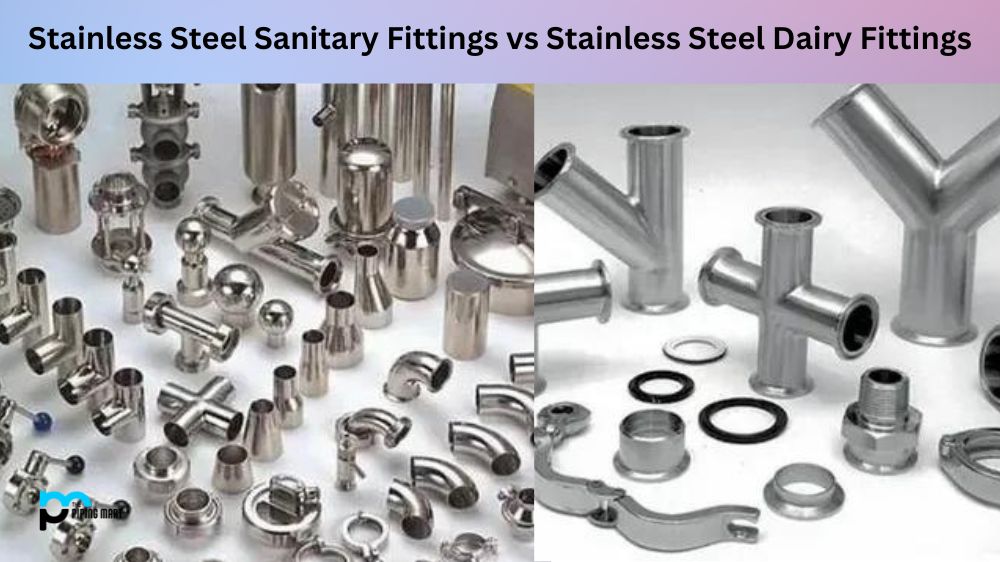When it comes to hygienic applications that require high cleanability and corrosion-resistant properties, stainless steel fittings are the go-to choice. In the food and beverage industry, two types of stainless steel fittings stand out—sanitary and dairy fittings. Despite many similarities, there are differences between these fittings that could impact their performance in different applications. As an expert in the field, I can provide informative information about the difference between stainless steel sanitary fittings and stainless steel dairy fittings.
Stainless Steel Sanitary Fittings
Stainless steel sanitary fittings are an important part of any plumbing system. They are used to securely join two pipes, valves or other components and with maximum hygiene. Many variations in size, material and design exist, with stainless steel being the most common due to its strength and corrosion resistance. Sanitary fittings are designed for use in areas that contain food or drinking water, making them ideal for commercial kitchens and laboratories where hygiene is essential.
Stainless Steel Dairy Fittings
Stainless steel dairy fittings are designed for use in settings that process, store, or transport dairy products. They have superior corrosion resistance and are resistant to pitting and cracking caused by exposure to chemicals used in the production of dairy products. These fittings come in various shapes and sizes for different applications, including valves, tees, couplings, elbows, unions, reducers and adapters. Their robust construction means they can easily withstand the harsh environments associated with food production without losing performance or product integrity.
Differences Between Stainless Steel Sanitary Fittings and Stainless Steel Dairy Fittings
Design Differences
While both fittings are made from high-quality stainless steel, their designs are different to match their respective applications. Sanitary fittings usually have smoother surface finishes with rounded corners and tapered ends to ensure easy cleaning and prevent bacteria growth. On the other hand, dairy fittings, designed specifically for dairy processing plants, have a more extended ferrule and bevel seat to create a secure seal that can withstand high pressures and frequent cleaning.
Application Differences
Despite being interchangeable in some scenarios, sanitary fittings are typically used for food, beverage, and pharmaceutical applications that demand high cleanliness and sterility levels. Sanitary fittings are also commonly found in chemical and oil industries. Dairy fittings, on the other hand, are specifically designed for dairy and cheese processing industries, where the fittings need to withstand hard chemicals and high-temperature liquids.
Connection Method Differences
Sanitary and dairy fittings’ interconnectivity differs since the dairy industry typically uses clamp connections, while sanitary industries prefer connections through various methods. Sanitary fittings are typically connected to other sanitary fittings through flanges, clamps, and other types of fitting, all with the same sanitary finish, which gives the fitting a smooth finish that is easy to clean.
Cost Differences
As you’d expect, sanitary fittings are usually more expensive than dairy due to the complex design, precision, and manufacturing equipment and process. It is worth noting that the precise design of a sanitary fitting makes it a worthwhile investment, specifically when food, beverage, medical, and pharmaceuticals are involved, making them ideal for industries with a higher risk of contamination. Dairy fittings, being more standardized and designed for the food industry, can be mass-manufactured at a lower cost than sanitary fittings.
Material Differences
The last differentiating aspect is that dairy fittings are often made of a narrower range of stainless steel grades like 304 and 316, while sanitary fittings are available in a broader range of grades like 304, 316L, and other alloys suitable for different applications. As a result, if you’re looking for a more corrosion-resistant fitting, you want to consider utilizing sanitary-grade fittings.
Conclusion:
In conclusion, stainless steel dairy and sanitary fittings perform similar functions in different industries. However, they have differences in functionality, design, connection methods, cost, and material choice. Understanding the differences between these fittings can help you determine the right fitting for your application and assist you in making informed purchasing decisions. Contact us today, and let our experts help you find the best stainless steel fitting for your needs.

A passionate metal industry expert and blogger. With over 5 years of experience in the field, Palak brings a wealth of knowledge and insight to her writing. Whether discussing the latest trends in the metal industry or sharing tips, she is dedicated to helping others succeed in the metal industry.




